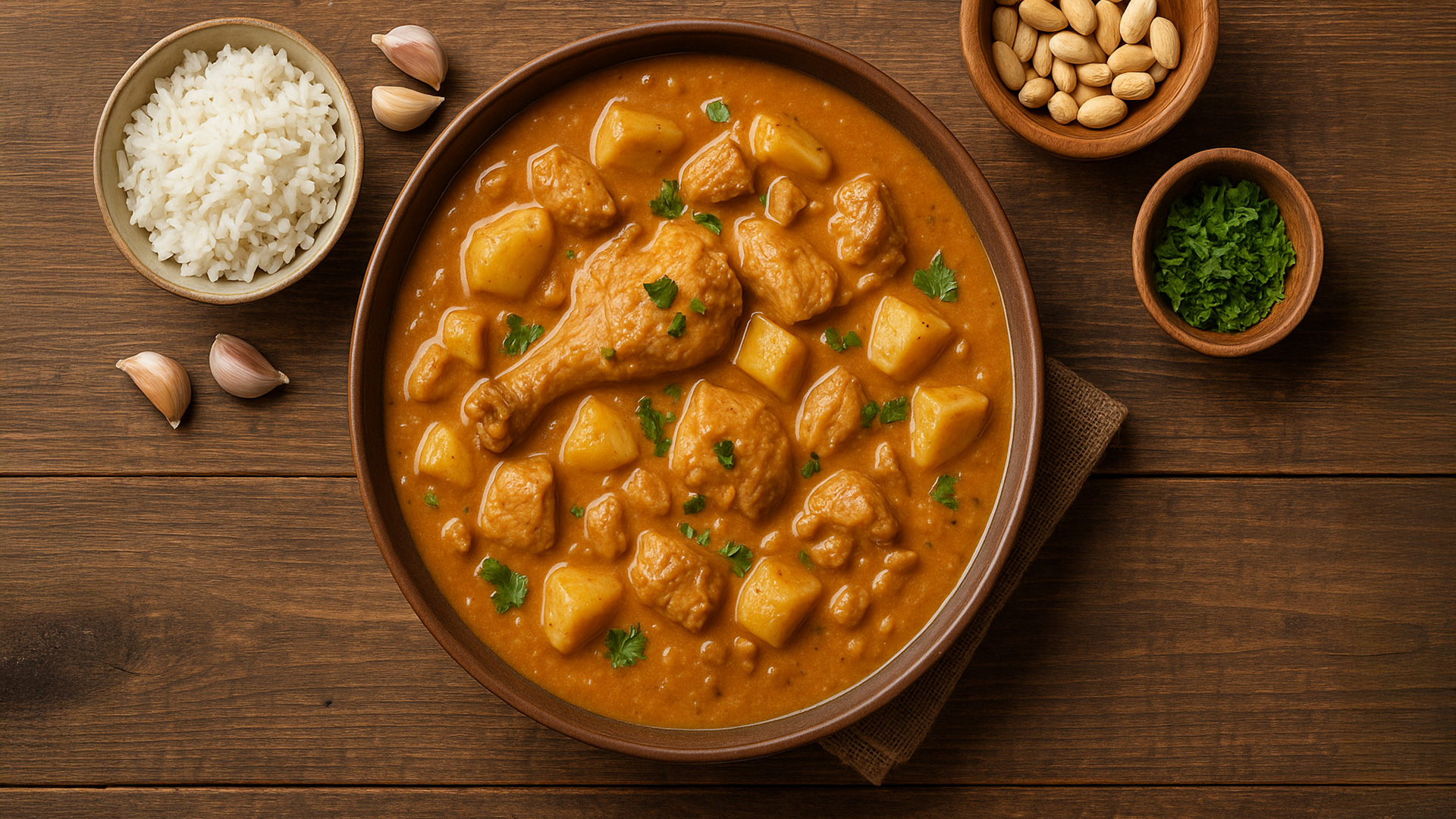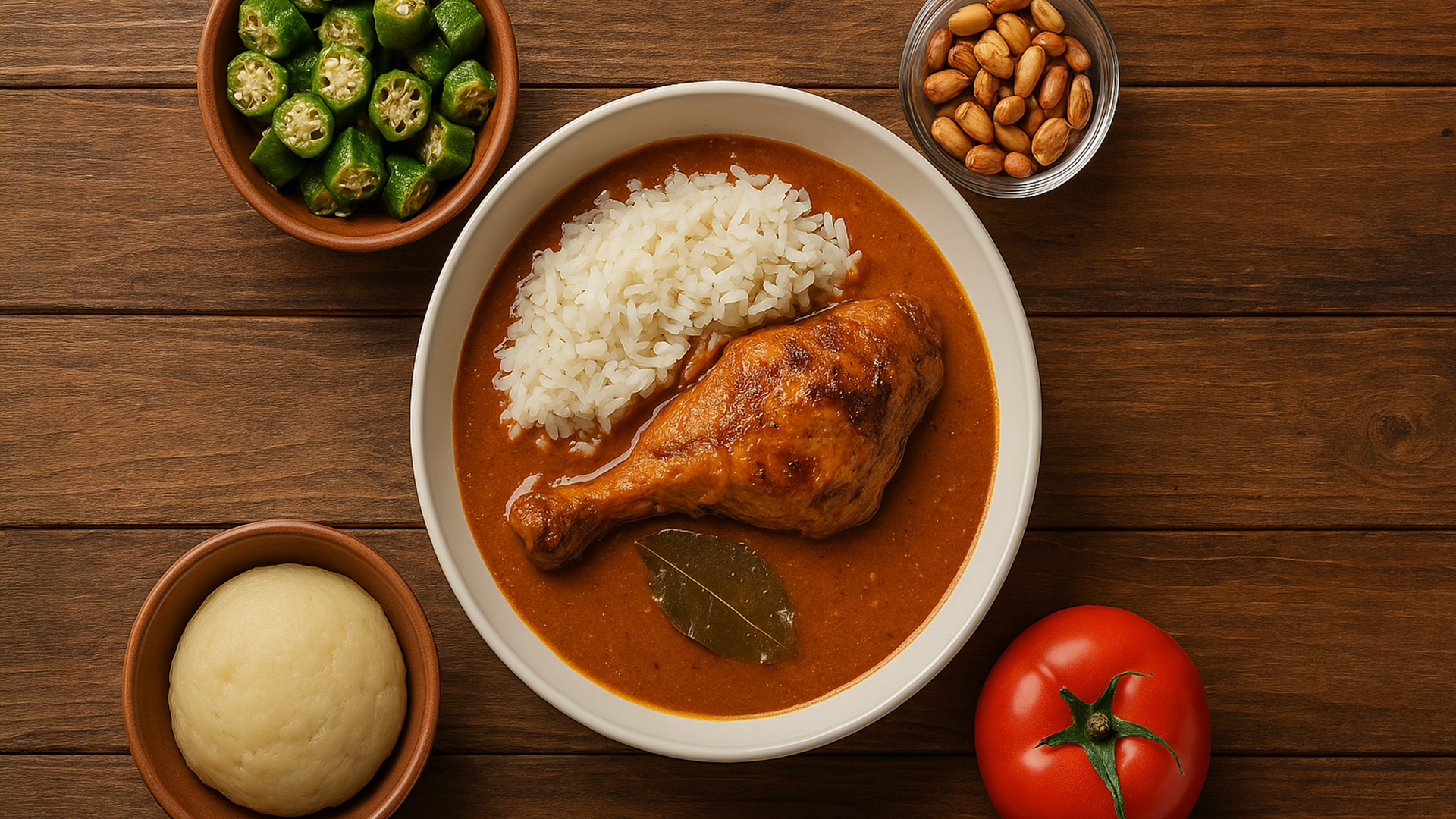Guinea-Bissau's most popular national dish is Caldo de Mancarra, which is rich in West African flavor and creamy and comforting. Every spoonful of this substantial peanut stew, which is simmered with tender chicken or fish, tomatoes, onions, and a thick groundnut sauce, packs a mouthwateringly nutty and savory punch. This dish, which is frequently served with cassava or fluffy white rice, unites families and fills the air with delicious scents. Caldo de Mancarra is a genuine taste of Guinea-Bissau's culinary soul, whether it is consumed at a festive event or during a peaceful dinner at home. Read More...
The History of Caldo de Mancarra – Guinea-Bissau’s Beloved National Dish:
Caldo de Mancarra, the rich and aromatic peanut stew, holds a special place in the heart of Guinea-Bissau’s culinary identity. Rooted in tradition and shaped by centuries of cultural blending, this hearty dish—based on ground peanuts, chicken or fish, tomatoes, and local spices—is more than a national favorite; it’s a symbol of the country’s resourceful cuisine and communal spirit.
Origins in West African Groundnut Culture:
Peanuts (known locally as mancarra from the Portuguese word amendoim) have long been a staple in West African agriculture and cuisine. Introduced to the region centuries ago—possibly through Portuguese trade routes—peanuts flourished in Guinea-Bissau’s climate and became a dietary cornerstone. Like many West African nations, Guinea-Bissau developed rich, peanut-based sauces and stews that became essential to both everyday meals and ceremonial occasions.
As peanut cultivation expanded in the 19th and 20th centuries, especially under colonial influence when groundnuts were exported in large volumes, the ingredient became even more central in domestic cooking. Over time, Caldo de Mancarra emerged as a defining expression of this peanut heritage, enhanced by local produce, regional spices, and the adaptability of being made with either fish or meat—depending on what was available.
A Dish of Community and Custom:
Traditionally, Caldo de Mancarra is slow-cooked over wood fires, often in large clay pots, and prepared in big batches to feed families or entire communities. The act of making the dish is communal in nature—whether it’s grinding peanuts by hand, preparing vegetables, or simmering the stew over open flames. It is often associated with celebrations, holidays, and religious feasts, and brings people together in the spirit of sharing and cultural pride.
Its role as a national dish is also reinforced by its flexibility and accessibility. It can be made with chicken, fish, or even goat, and served with rice, cassava, or fufu—making it a dish adaptable to both rural and urban settings across ethnic groups.
Colonial Influences and Culinary Resilience:
During Portuguese colonization, European techniques and ingredients merged with local traditions. While the peanut base remained uniquely African, elements such as tomato paste and bouillon cubes were added to enhance flavor, showing how Caldo de Mancarra evolved into a culinary hybrid—fusing indigenous techniques with colonial-era ingredients.
After independence in 1973, the dish remained a comforting constant, a reminder of the country’s resilience and unity amid decades of political and economic upheaval. It continues to be celebrated today not only in homes but in Bissau’s restaurants and at cultural festivals.
Conclusion: A Stew of Heritage and Heart:
Caldo de Mancarra is more than just a dish—it is a cultural anchor in Guinea-Bissau’s identity. It embodies the richness of local ingredients, the resourcefulness of the Bissau-Guinean people, and the warm, communal nature of West African hospitality. In every velvety spoonful of this peanut stew lies a story of history, survival, and delicious tradition.
Season and brown the chicken:

Sauté aromatics:
Incorporate tomato paste and spices:

Blend in peanut base:
Return chicken and simmer:

Add optional vegetables (if using):
Serve:
The total preparation and cooking time for **Caldo de Mancarra** is approximately **1 hour and 30 minutes to 2 hours**. Prepping the ingredients—such as chopping onions and tomatoes, seasoning the chicken, and blending or measuring out the peanut butter—takes around **20 to 30 minutes**. Cooking the dish, which includes browning the meat, sautéing the aromatics, and simmering the stew until thick and flavorful, takes about **1 to 1½ hours** depending on the cut of meat and desired consistency. While not a fast dish, the slow cooking process is essential for developing its rich, nutty flavor and velvety texture.
A single serving of Caldo de Mancarra, based on the recipe provided and assuming six servings, contains approximately 500 to 600 calories. The main contributors to the calorie count are the chicken (about 250–300 calories depending on cut and portion), peanut butter (around 150–180 calories per serving from the rich, creamy sauce), and vegetable oil used in sautéing (about 50–70 calories). The rest comes from the onions, tomatoes, and optional vegetables, which add minimal calories but enhance flavor. If served with white rice or cassava, an additional 100–150 calories should be added per serving, making it a satisfying and hearty meal.







